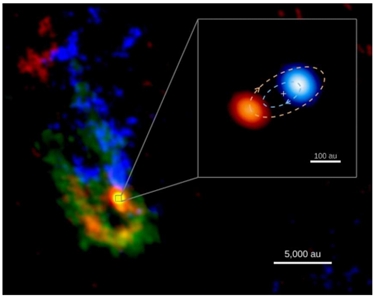Figure
Mystery of birth of massive binary: dynamics of forming two protostars elucidated with ALMA
A team of researchers from RIKEN, National Astronomical Observatory of Japan, and Osaka University discovered young massive stars in a binary system, a star system with two stars orbiting around their center of mass, with Atacama Large Millimeter/submillimeter Array (ALMA), an astronomical interferometer located in Chile.
Recent studies showed that most massive stars have some 8 or more times the mass of the Sun and possess orbiting stellar companions. It is thought that a massive star is born by gravitational contraction of thick gas clouds; however, it was unclear whether these binary stars were born together by slow contraction of gas clouds or were born separately and paired up later.
Understanding the dynamics of forming binaries has been difficult because it is impossible to detect short wave length light from stars hidden in a cloud of gas and dust and it is difficult to observe the formation of a binary system far away from the Earth with sufficiently high spatial resolution.
In this study, with ALMA, the team observed the radio waves from a star-forming region known as IRAS 07299-1651, which is located about 5,500 light-years away from the Earth, finding two objects, a massive “primary” protostar and another “secondary” protostar. They are separated by a distance of about 180 astronomical units (about 270 million km), the closest proximity ever determined for young massive stars found in the area. Detailed analysis of observation results showed that they were orbiting each other with a period of at most 600 years and had a total mass at least 18 times that of the Sun.
From accretion of gas on near circular disk orbits and other observation results, the team concluded that it was highly likely that the secondary star of the binary formed as a result of fragmentation of the disk originally around the primary. However, it is necessary to observe other examples with high spatial resolution in order to see whether this is a unique situation or common to birth of all massive stars.
The scenario of disk fragmentation suggests the birth of a binary star system with a nearly circular orbital path. Future observations may test the disk fragmentation scenario by determining whether the orbit is close to circular or not.

The Article, “Dynamics of a Massive Binary at Birth” was published in Nature Astronomy at DOI: https://doi.org/10.1038/s41550-019-0718-y.
Related links











